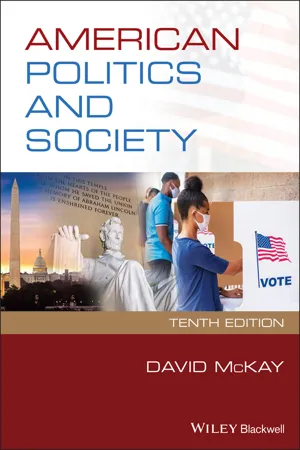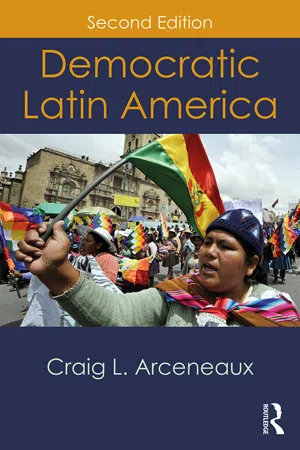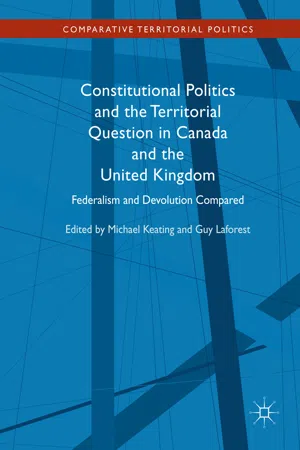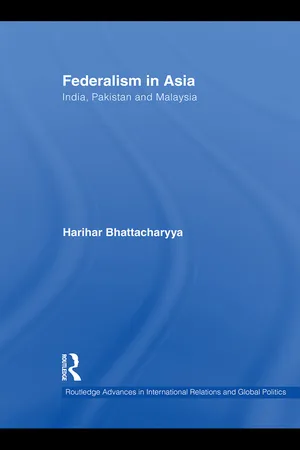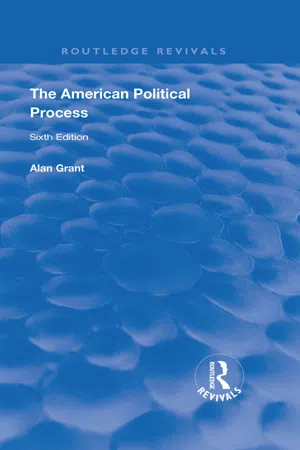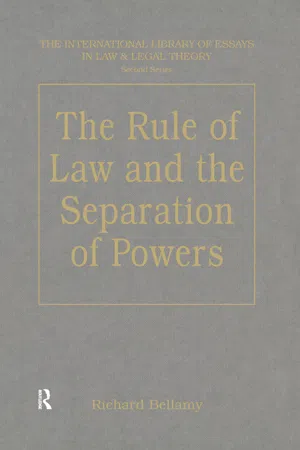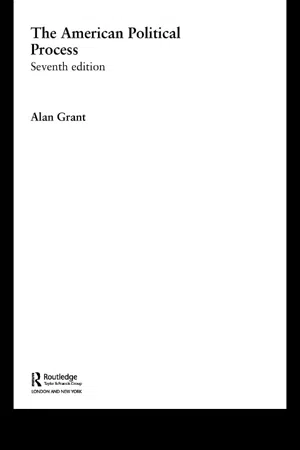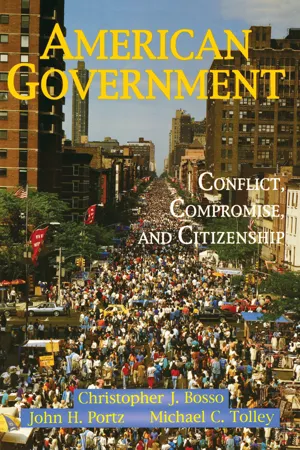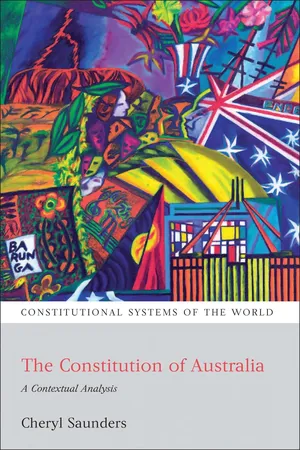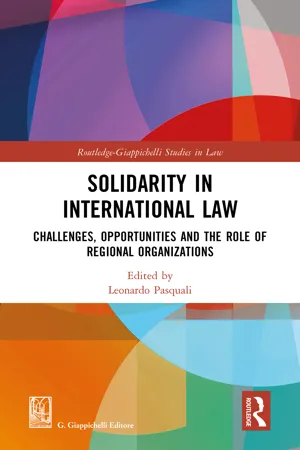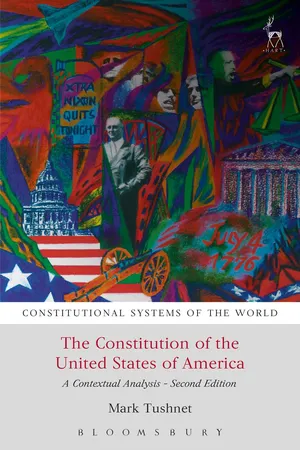Law
Federalism
Federalism is a system of government in which power is divided between a central authority and constituent political units, such as states or provinces. This division of power allows for a balance between national and regional interests, and it often involves a written constitution that delineates the powers of each level of government. In the United States, for example, federalism is a fundamental principle of the Constitution.
Written by Perlego with AI-assistance
Related key terms
12 Key excerpts on "Federalism"
- eBook - ePub
- David McKay(Author)
- 2021(Publication Date)
- Wiley-Blackwell(Publisher)
To many foreign observers, the practice of American Federalism presents itself as something of a conundrum. On the one hand is the extraordinary variety of contrasting public policies displayed by the states. Most states levy an income tax, but some do not; most have capital punishment and as of 2020, 28 states allow it while 22 do not; state-mandated land-use planning is light years away from the policy agenda in Texas – a state which prides itself on its free market in land – but in Hawaii state planning is a fact of life. In Louisiana laws governing the sale of intoxicating liquors are lax, while Utah has very restrictive laws on the sale of alcohol. On the other hand, American observers repeatedly tell us that Federalism is dying, or is even dead; that the federal government has effectively usurped the powers of the states and now plays the dominant role in American government. Federalism, so we are told, has been transformed from a system of shared sovereignty with each level of government supreme in its own sphere and converted into a complex web of intergovernmental relations where political and economic forces, not constitutional imperatives, are the key variables. A major purpose of this chapter is to explain the apparent paradox of continuing state variety and increasing federal power. To achieve this, attention is paid to what has been called ‘fiscal Federalism’, or the financial relations between different levels of government, and to recent attempts to revive the institution of Federalism. In addition the chapter will focus on the role that the states play as policy innovators in areas as diverse as health care and environmental protection – a role that has taken on a new significance in the last 20 years.Federalism in Theory and Practice
As outlined in Figure 4.1 , there are three basic forms of government operating in the modern world. Under unitary government sovereignty is vested in the central authorities, which can in turn decide on the shape of regional and local governments. This is the case in such countries as France and Japan. Under confederal arrangements sovereignty is vested in the state or regional governments, whose agreement is required in order to sanction action by the central government. The US Articles of Confederation and the Confederacy during the Civil War operated roughly in this way, and such organizations as the United Nations and NATO approximate to confederal systems. The defining feature of Federalism is that of dual sovereignty or a sharing of powers between state and central governments. Under Federalism each level of government is assumed to be supreme in at least one policy area. Typically the federal government would have responsibility for defence and foreign affairs, while the states would control such things as education and law and order. The three models represented in Figure 4.1 - eBook - ePub
- Craig L. Arceneaux(Author)
- 2017(Publication Date)
- Routledge(Publisher)
Federalism offers institutions geared toward the accommodation of diverse interests, but it requires a delicate balance as it disperses authority. Too much dispersion can feed calls for independence, and too little makes a mockery of the federal arrangement. And Federalism is not without its costs. Policymaking at lower levels creates redundancies, increases the need for coordination, and spawns new arenas and opportunities for political conflicts. Despite this, proponents of the institution highlight how Federalism allows policy experimentation in different government districts and lets politicians gain experience as they pursue higher offices. Moreover, Federalism may be the only feasible option for large countries with diverse populations. Only four countries in Latin America use federal arrange-ments—Argentina, Brazil, Mexico, and Venezuela. But together, these countries make up the vast majority of the region’s population and landmass. And although other countries do not share federal institutions, they too must confront questions of governance at lower levels. This chapter evaluates the various constitutional designs that link national and subnational politics, and concludes with a case study of Brazil.Federalism and Unitarism, and the Range of CentralizationFor practical reasons, most governments split their work between a single central government and lower-level governments. But federal regimes reinforce this division of labor with constitutional provisions that guarantee each level of government the final say over a set of policy responsibilities. Ideally then, Federalism promotes both self-rule and shared rule. It offers distinct groups a level of autonomy in the making of certain decisions, but it also asks these groups to collaborate on other decisions (Elazar, 1987, pp. 5–6). In a unitary regime, final authority in all policy areas rests in the national government. A unitary regime may allocate power to a regional government, but unlike in the federal regime, such authority can be legally retracted.The Division of Power in a Federal SystemFederalism entails a rather common division of labor in most countries. Foremost, only the national government holds international sovereignty and the unqualified right to enter into international agreements with other countries. Subnational units enjoy sovereignty, but only in respect to each other and the central government (Gibson, 2004, pp. 5–6). To support its role in the global arena, national governments usually retain primary competencies over matters of defense, and take charge of economic planning. Lower levels of government typically focus on social affairs such as health, education, welfare, and cultural programs, as well as the maintenance of law and order. - eBook - ePub
Constitutional Politics and the Territorial Question in Canada and the United Kingdom
Federalism and Devolution Compared
- Michael Keating, Guy Laforest, Michael Keating, Guy Laforest, Michael Keating, Guy Laforest(Authors)
- 2017(Publication Date)
- Palgrave Macmillan(Publisher)
That Canada’s Constitution is genuinely federal rather than being intended to accumulate power at the centre, has been recognized many times by the courts, notably in this passage from a judgment of the Judicial Committee Privy Council 9 that has since become a classic: The object of the Act was neither to weld the provinces into one, nor to subordinate provincial governments to a central authority, but to create a federal government in which they should all be represented, entrusted with the exclusive administration of affairs in which they had a common interest, each province retaining its independence and autonomy. (Liquidators of the Maritime Bank of Canada v. Receiver - General of New Brunswick [ 1892 ] A.C. 437, 440–442) More recently, the Supreme Court has expressed itself in similar fashion, in particular in Reference re Secession of Quebec, in which it stated that Federalism is one of the constitutional principles underlying the written Constitution, and that ‘there can be little doubt that the principle of Federalism remains a central organizational theme of our Constitution’ (Reference re Secession of Quebec [ 1998 ] pp. 250–251). Therefore, the Court considers that the idea of Federalism can be used not only to guide the courts in the interpretation and application of the provisions of the constitutional text, but also to fill any gaps. The Supreme Court has stated several times that the autonomy of each level of government lies at the heart of the federative principle (For example, ibid. par. 58). It also refers, in several places, to the need to preserve a balance between the respective powers of each order. 10 And, in addressing its own role, the Court has said that whilst it ‘falls primarily to governments,’ to preserve the balance, the Court should define and apply doctrines for the implementation of power-sharing that promote ‘the legitimate interplay between federal and provincial powers’ (Canadian Western Bank [ 2007 ] par. 24, 36) - eBook - ePub
- Harihar Bhattacharyya(Author)
- 2010(Publication Date)
- Routledge(Publisher)
Two intertwined principles are involved in the federal idea: self-rule and sharedrule. According to Elazar (1987), Federalism, on the basis of the combination of those two principles, is able to link ‘individuals, groups and polities in lasting but limited union in such a way as to provide for the energetic pursuit of common ends while maintaining the respective integrities of all parties’ (Elazar 1987:115). Federalism then, as a political principle, refers to constitutional diffusion of powers among the constituent elements in a way that fulfils the desire for unity for some common purposes and autonomy for some other purposes. For Elazar then, Federalism, politically speaking, has served as one of the three forms (the other two are conquest, and organic) that polities have been historically organized (Elazar 1987:2). In the sense that Federalism is covenantal, it is thought to involve choice on the part of the covenanting parties.Although the idea of Federalism gained popularity particularly among the countries in Latin America, Asia and Africa after the Second World War, in Europe, due to the heavy impact of the French Revolution and the idea of the nation-state (which turned out to be the predominant form of political organization), Federalism did not have much sway. Bereciartu (1994) sees Federalism as a European dream but realized outside of Europe (Bereciatru 1994:166). Riker rightly says that federations were rare before the nineteenth century.The real proliferation of federations took place in the post-Second World War period mostly in the former colonies in Asia and Africa, but also in Europe, with the overriding need to unite multicultural societies. But such experiments were fraught with a host of problems, and as Ronald L. Watts, the world-famous authority on Federalism has shown, many of such experiments were cancelled or suspended (Watts 1966:9). Again, of the three federations in Asia (India, Pakistan and Malaysia) India has achieved greater successes in uniting a vast and ethno-linguistically diverse country, although Malaysia and Pakistan have not experienced further disintegration after 1965 and 1971 respectively. By the 1980s, the limitations of such experiments were clear. Watts wrote: ‘These experiences suggested that, even when undertaken with the best of motives there are limits to the appropriateness of federal solutions or particular federal forms in certain circumstances’ (Watts 1966:9). - eBook - ePub
- Alan Grant(Author)
- 2019(Publication Date)
- Routledge(Publisher)
8 Federalism and Regional DiversityThe Federal Principle
The Founding Fathers established a system of government at the Philadelphia Convention in 1787 which was the result of the compromises necessary to reconcile the conflicting political and economic interests present. Federalism was in fact a ‘half-way house’ between the concept of a centralized unitary state that was unacceptable to the thirteen states jealous of their own independence and that of a confederation which was a weak association of autonomous states of the kind that had proved unsatisfactory between 1776 and 1787. Federalism arose out of a desire to bolster national unity while at the same time accommodating regional diversity. The Constitution itself does not mention anywhere the terms ‘Federalism’ and ‘federation’ but the United States has been recognized ever since as the major example of this compromise form of unity. Many other nations later attempted to adopt the federal principle which K.C. Wheare describes as:The method of dividing powers so that the general and regional governments are each, within a sphere, co-ordinate and independent.1Wheare says that the fundamental characteristic of the United States as an association of states is that the Constitution establishes an arrangement whereby powers are divided between a general (that is national or federal) government, which in certain matters is independent of the governments of the associated states, and state governments, which in certain matters are independent of the general government. Both national and state governments operate directly upon the people and each US citizen is subject to two governments.The American federal system should not be seen therefore as a pyramid structure with the federal government at the apex, the states below it and the local governments as the base, because in constitutional terms at least the federal and state governments are of equal status with their own distinctive areas of authority. What is true, however, is that local government units are subordinate bodies and creatures of the states; their boundaries and powers can be altered as the state determines, because the 50 states are unitary systems in their own right. - eBook - ePub
- Richard Bellamy, Richard Bellamy(Authors)
- 2017(Publication Date)
- Routledge(Publisher)
147The balance of powers inherent in devolutionary Federalism aims at reconciling societal pluralism with a decent level of national cohesion. The component entities reflect the linguistic, religious, cultural, ethnic or simply regional differences existing within the country. Sometimes, these differences coincide with economic and social cleavages among the component entities. The central government stands for solidarity among the component entities and represents the nation as a whole.148The picture that surfaces is one in which the central government devolves some of its powers to the component entities by express grant, possibly widened by the recognition of the necessary implications of such grant (i.e. the implied powers) in favor of the component entities. The residuary power rests with the central government, since it is still perceived as the ordinary bearer of sovereignty.149However, given the basic distrust between the central government and the component entities - a constitutional undertone which contrasts sharply with the model of integrative Federalism150 - the relationship between the powers’ spheres tends to be mutually exclusive. Devolutionary Federalism therefore comes close to the concept of dual Federalism, which seems discredited in American constitutional law.151The component entities defend the full size of the powers conferred upon them, whether or not they have exercised these powers. In their view, any further interference by the central government with the exercise of the powers granted to the component entities, must be rejected on the ground that the grant of powers is exclusive. The opposition of the component entities against a concurrent power for the central government over matters belonging to their sphere of responsibility mostly stems from the fear that the central government could be dominated by a competing component entity.152 Only a sealing-off of the sphere of powers of the component entities as opposed to that of the central government seems appropriate to achieve the independence to which each component entity aspires in order to meet the needs flowing from its own identity within the broader national context.153 - eBook - ePub
- Alan Grant(Author)
- 2003(Publication Date)
- Routledge(Publisher)
8 Federalism, the states and local governmentThe federal principle
The Founding Fathers established a system of government at the Philadelphia Convention in 1787 which was the result of the compromises necessary to reconcile the conflicting political and economic interests present. Federalism was in fact a ‘half-way house’ between the concept of a centralised unitary state that was unacceptable to the 13 states jealous of their own independence and that of a confederation which was a weak association of autonomous states of the kind that had proved unsatisfactory between 1781 and 1787. Federalism arose out of a desire to bolster national unity while at the same time accommodating regional diversity. The Constitution itself does not mention anywhere the terms ‘Federalism’ and ‘federation’ but the United States has been recognised ever since as the major example of this compromise form of unity. Many other nations later attempted to adopt the federal principle which K.C. Wheare describes as: ‘The method of dividing powers so that the general and regional governments are each, within a sphere, co-ordinate and independent.’1Wheare says that the fundamental characteristic of the United States as an association of states is that the Constitution establishes an arrangement whereby powers are divided between a general (that is national or federal) government, which in certain matters is independent of the governments of the associated states, and state governments, which in certain matters are independent of the general government. Both national and state governments operate directly upon the people and each US citizen is subject to two governments.The American federal system should not be seen therefore as a pyramid structure with the federal government at the apex, the states below it and the local governments as the base, because in constitutional terms at least the federal and state governments are of equal status with their own distinctive areas of authority. What is true, however, is that local government units are subordinate bodies and creatures of the states; their boundaries and powers can be altered as the state determines, because the 50 states are unitary systems in their own right. - eBook - ePub
American Government
Conflict, Compromise, And Citizenship
- Christopher J Bosso, John Portz, Michael Tolley(Authors)
- 2018(Publication Date)
- Routledge(Publisher)
chapter 2 ). In the 1830s, when he visited the United States, the nation had one of the world’s more complicated systems of government. It still does. Moreover, American Federalism is constantly changing. As we will see, in Tocqueville’s day the national government was far more “circumscribed”—that is, limited—than it is today.A BALANCING ACTA federal system is an oddity. It isn’t a unitary system, in which all power and responsibility are centralized in a national government. Tocqueville’s native France was, and still is, a unitary system with power centered in the national government located in Paris, even though the specific type of government has changed from a monarchy to a republic.Neither is Federalism a confederation, in which power and responsibility are decentralized among many subnational governments, be they provinces, cantons, departments, or states. America under the Articles of Confederation was such a system. So was the Confederate States of America during the Civil War.Federalism is a hybrid. It is neither pure centralization nor pure decentralization. In Federalism neither the national government nor the states hold all power. In American Federalism today the national government is supreme, especially in matters of national defense, but a great deal of power and responsibility remains in the hands of the states. Federalism thus is a system in which power and responsibility are divided among and shared by the national and subnational governments (see Box 3.1 on pages 90 and 91).A CONFUSING SYSTEMFor citizens, this division of power and responsibility poses practical problems. Often it is not clear which government is responsible for which policy areas. In some areas, such as national defense, the federal government clearly runs the show, but in others there may be great variation from one state to another. For example, civil rights (such as ensuring the right to vote) typically are enforced on a national basis by the federal government. However, responsibility for primary education is in the hands of the states and, particularly, thousands of local school systems. In France, by contrast, all primary school curricula and rules are established by the national government. In a federal system, just knowing which government is in charge is a challenge. - eBook - ePub
The Constitution of Australia
A Contextual Analysis
- Cheryl Saunders(Author)
- 2010(Publication Date)
- Hart Publishing(Publisher)
7
Federalism
Principle – Power and Authority – Social and Economic Union – Co-operationI. PRINCIPLE
A. Significance
i. Federalism and the Constitution
F EDERALISM IS CENTRAL to the Australian Constitution. Without Federalism, the six Australian colonies would not have come together in a single political system at the end of the nineteenth century. The Constitution on which they agreed was designed to establish and protect the autonomy of two spheres of government that Federalism requires. The Constitution was essential to Australian Federalism, but the converse also was true: Federalism provided the rationale for a written, entrenched Constitution, given overriding effect through judicial review. Absent the desire to establish a federal form of government, the Australians may not have felt any need for a Constitution that functioned as fundamental law.Federalism permeates the written Constitution. The first three chapters divide legislative, executive and judicial competence between the Commonwealth and the States. Other provisions strengthen union through guarantees of internal mobility that assume the federal division of the territory. The few express rights protecting provisions apply only within the sphere of authority of the Commonwealth, leaving the States to determine their own standards. And significantly, as earlier chapters have shown, the framework for the institutions of Commonwealth government also reflects the federal structure of the state: in the design of the Senate; in the guarantee of minimum State representation in the House of Representatives; in the prohibition against federal electorates straddling State boundaries; and in the requirement for the approval of proposals for constitutional change by the people organised in States as well as by the people organised nationally.ii. Form of the Federation
- eBook - ePub
- David McKay(Author)
- 2017(Publication Date)
- Wiley-Blackwell(Publisher)
The condition where conflict between the states and federal government existsThe condition where the relationship between the states and the federal government is essentially cooperativecooperative FederalismThose policies that involve economic and social development, such as transportation and urban renewaldevelopmental policiesThe division of power and sovereignty between different levels of governmentdual sovereigntyGuaranteeing funding for specific constituency projects or benefits as attachments to billsearmarkingThose aspects of Federalism involving taxing and spendingfiscal FederalismThe financial total of all activity in the economyGross Domestic Product (GDP)The political relationship between federal, state and local governmentintergovernmental relationsThe devotion of citizens to a local territory or jurisdictionlocalismThe label attached to Ronald Reagan’s attempts to devolve power to the statesNew FederalismThe institution of universal testing of schoolchildren’s performance by the federal governmentNo Child Left Behind Act (NCLB)Legislation designed to benefit individual constituenciespork-barrel politicsPolicies designed to redistribute resources across social classes, age cohorts or jurisdictionsredistributive policiesPowers designed to regulate economic, social or political activityregulatory powersFederal policies requiring states to implement policies but not funded by the federal governmentunfunded mandatesPolicies with provisions designed to assess the social and economic impact of programmesworkable programmeNotes
1 The classic statement on the nature of dual Federalism is by Morton Grodzins, The American System (Chicago: Rand McNally, 1966).2 This abbreviation is taken from Deil S. Wright, Understanding Intergovernmental Relations - eBook - ePub
Solidarity in International Law
Challenges, Opportunities and The Role of Regional Organizations
- Leonardo Pasquali, Leonardo Pasquali(Authors)
- 2022(Publication Date)
- Routledge(Publisher)
If for the aforementioned social doctrine, Federalism does not wait for the State to appear, the reciprocal is not the same when it comes to the theory of the Federal State. Despite the assertion that it is necessary to have a balance between the constitutionally foreseen Federation and its social bases, it is important to note that the Federal State is only born when its provision is in a Constitution. Therefore, while for the social doctrine there can be Federalism without a Federal State, the same does not happen in relation to the theory of the Federal State, which only accepts Federalism if it is duly recognized in the constitutional text.It is important to highlight that, whether as a constitutional application or as a social doctrine, the substrate that conveys the matrix idea of Federalism provides for a middle point of distribution and attribution of powers, and therefore, its excessive centralization is not accepted. Thus, both the theory of the Federal State and the social doctrine have an intersecting element: the denial of excessive centralization.Thus, Federalism can be seen under two prisms: that of a social vision that transcends the constitutionalization of a form of State and, also, at the constitutional level, that of a form of State, which constitutionalizes of the organization and spatial division of Powers. There is, therefore, Federalism in non-federal countries and organizations that have some level of political decentralization.Federalism, whether dealing with a social doctrine or not, is a means of preserving sectoral differences, while also providing a certain degree of homogenization. Thus, at first sight, the old phrase that identifies Federalism as the union of diversity in unity remains current, characterizing its matrix idea, whether applying it in the theory of the Federal State or, even, in other sectors of society.In fact, Federalism has several concrete achievements, making it difficult to establish a model that must necessarily be observed and assimilated by all States that adopt that form. Or, in other words, it is not possible to impose ideal models, standards of forms of State, since it will be up to the peculiar political evolution of each State and society to adopt the decision most pertinent to its reality. There are, therefore, several ‘Federalisms’. - eBook - ePub
The Constitution of the United States of America
A Contextual Analysis
- Mark Tushnet(Author)
- 2015(Publication Date)
- Hart Publishing(Publisher)
44 Moving from the descriptive claim that there are political safeguards to the normative one that those safeguards are ‘effective’ is almost certainly a mistake. Normative defenses of Federalism typically assert that there are good reasons for organizing a government as a federal one. Federalism, it is said, limits the possibility of tyranny by making it possible for people to move easily from one location to another, thereby giving rulers an incentive to develop freedom-promoting policies that keep people from moving. It also helps achieve greater social welfare by allowing people with different values to live in subnational units and enact the policies that they like even though people living elsewhere, with different values, like different policies. And it is said to be a useful way of experimenting with various social policies until we see which policy works best, at which point the national government can scale-up a policy that succeeded locally. Notably, though, these defenses of Federalism tell us almost nothing about how much centralization is too much—other than, perhaps, that complete centralization of all policies at the national level is a bad idea. That Federalism is a good idea does not help us decide whether any particular distribution of power between state and nation is normatively desirable or ‘effective’.What we do know is that efforts to develop sensible doctrinal limits on centralization have not succeeded. The reason may lie in the specifics of US constitutionalism: The words of the Constitution, or the nation’s constitutional tradition, may be inadequate to generate sensible doctrine. What is left are the political safeguards of Federalism. We can note that they operate without contending that the safeguards work ‘well’ in some normative sense. The political safeguards of Federalism arise out of ordinary political calculations about what course of action increases a national legislator’s chances of reelection or a candidate’s chances for election. No doubt the twentieth century saw centralization of power on a large scale, and a concomitant whittling down of state and local governing authority. And that trend might well continue. Politics and economics probably explain the centralizing trend. An increasingly interconnected economy produces problems that nearly everyone thinks are better addressed at the national level. National politicians do not have to grab power, because, to overstate the point, no one really resists them. In the absence of some coherent normative account of the distribution of authority created by the US Constitution, the political safeguards simply are how the efficient Constitution implements Federalism.
Index pages curate the most relevant extracts from our library of academic textbooks. They’ve been created using an in-house natural language model (NLM), each adding context and meaning to key research topics.
